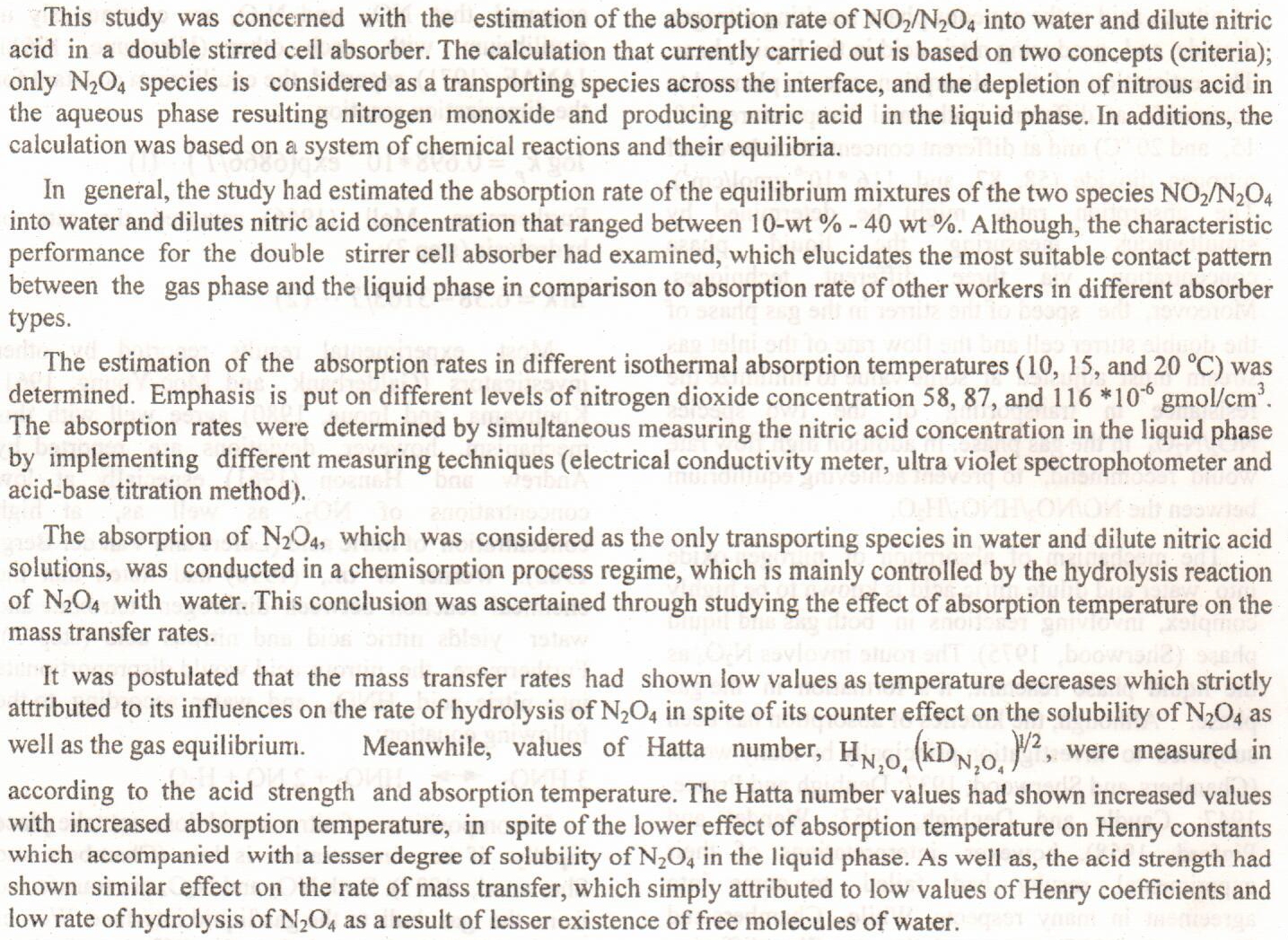
Denture cleansing is an essential step that can stop cross‑contamination and adds to the health of the patient, denture durability, and the general quality of life. A disinfection technique must be practical and devoid of damaging effects on the material's properties used to construct the denture base. The main aim of this study is to evaluate the effect of three concentrations of electrolyzed water denture cleanser on heat cure acrylic and polyamide after immersion in electrolyzed water. The evaluation is based on their efficacy on surface hardness, wettability, and color stability compared with one submerged in distilled water as a control group. The method consists of eighty samples of heat-cured acrylic and polyamide material.
... Show More (2)
(2)
 (3)
(3)
 (2)
(2)
 (3)
(3)
 (2)
(2)
In this paper, the ability of using corn leaves as low-cost natural biowaste adsorbent material for the removal of Indigo Carmen (IC) dye was studied. Batch mode system was used to study several parameters such as, contact time (4 days), concentration of dye (10-50) ppm, adsorbent dosage (0.05-0.25) gram, pH (2-12) and temperature (30-60) oC. The corn leaf was characterized by Fourier-transform infrared spectroscopy device before and after the adsorption process of the IC dye and scanning electron microscope device was used to find the morphology of the adsorbent material. The experimental data was imputing with several isotherms where it fits with Freundlich (R2 = 0.9937) and followed pseudo second order kinetic. The hi
... Show More (8)
(8)
 (6)
(6)
In this paper, the ability of using corn leaves as low-cost natural biowaste adsorbent material for the removal of Indigo Carmen (IC) dye was studied. Batch mode system was used to study several parameters such as, contact time (4 days), concentration of dye (10-50) ppm, adsorbent dosage (0.05-0.25) gram, pH (2-12) and temperature (30-60) oC. The corn leaf was characterized by Fourier-transform infrared spectroscopy device before and after the adsorption process of the IC dye and scanning electron microscope device was used to find the morphology of the adsorbent material. The experimental data was imputing with several isotherms where it fits with Freundlich (R2 = 0.9
... Show More (8)
(8)
 (6)
(6)
This studies deals with investigated the potential of a Iraqi bentonite clay for the adsorption of bromo phenol red dye from contaminated water. Impulse adsorption experiments were performed. The contact time influence of initial dye concentration, temperature, pH, ionic strength, partical size adsorbent and adsorbent dosage on bromo phenol red adsorption are investigated in a series of batch adsorption experiments. Adsorption equilibrium data were analyzed and described by the Freundlich, Langmuir and temkin isotherms equations. Thermodynamic parameters inclusive the Gibbs free energy (∆G• ), enthalpy (∆H• ), and entropy (∆S• ), were also calculated. These parameters specified that adsorption of bromo phenol red onto bentonite
... Show Morecharge transfer complex formed by interaction between the p- aminodiphenylamine (PADPA) as electron donor with iodine as electron acceptor in ethanol at 250C as evidenced by color change and absorption. The spectrum obtained from complex PADPA – Iodine shows absorptions bands at 586 nm. All the variables which affected on the stability of complex were studies such as temperature, pH, time and concentration of acceptor. The linearity of the method was observed within a concentration rang (10–165) mg.L-1 and with a correlation coefficient (0.9996), while the molar absorbitivity and sandell sensitivity were (4643.32) L.mol-1.cm-1 and (0.0943) μg.cm-2, respectively. The adsorption of complex PADPA–I2 was studied using adsorbent surfaces
... Show MoreThis paper presents the ability to use cheap adsorbent (corn leaf) for the removal of Malachite Green (MG) dye from its aqueous solution. A batch mode was used to study several factors, dye concentration (50-150) ppm, adsorbent dosage (0.5-2.5) g/L, contact time (1-4) day, pH (2-10), and temperature (30-60) The results indicated that the removal efficiency increases with the increase of adsorbent dosage and contact time, while inversely proportional to the increase in pH and temperature. An SEM device characterized the adsorbent corn leaves. The adsorption's resulting data were in agreement with Freundlich isotherm according to the regression analysis, and the kinetics data followed pseudo-first-or
... Show More (5)
(5)
The preparation of low cost activated carbon from date stones and microwave method by using K2CO3 as chemical activator were investigated.
The prepared activated carbon was used to remove fluoroquinolones antibiotics from aqueous solution. The characterizations of the activated carbon is represented by surface area, pore volume, ash content, moisture content, bulk density, and iodine number. The adsorbed fluoroquinolones antibiotics are Ciprofloxcin (CIP), Norfloxcin (NOR) and Levofloxcin (LEVO). Different variables as pH, initial concentrations and contact time were studied to show the efficieny of prepared activated carbon. The experimental adsorption data were analyzed by Lungmuir, Freundlich
... Show MoreThis paper presents the ability to use cheap adsorbent (corn leaf) for the removal of Malachite Green (MG) dye from its aqueous solution. A batch mode was used to study several factors, dye concentration (50-150) ppm, adsorbent dosage (0.5-2.5) g/L, contact time (1-4) day, pH (2-10), and temperature (30-60) The results indicated that the removal efficiency increases with the increase of adsorbent dosage and contact time, while inversely proportional to the increase in pH and temperature. An SEM device characterized the adsorbent corn leaves. The adsorption's resulting data were in agreement with Freundlich isotherm according to the regression analysis, and the kinetics data followed pseudo-first-order kinetic with a correlation
... Show More (5)
(5)
